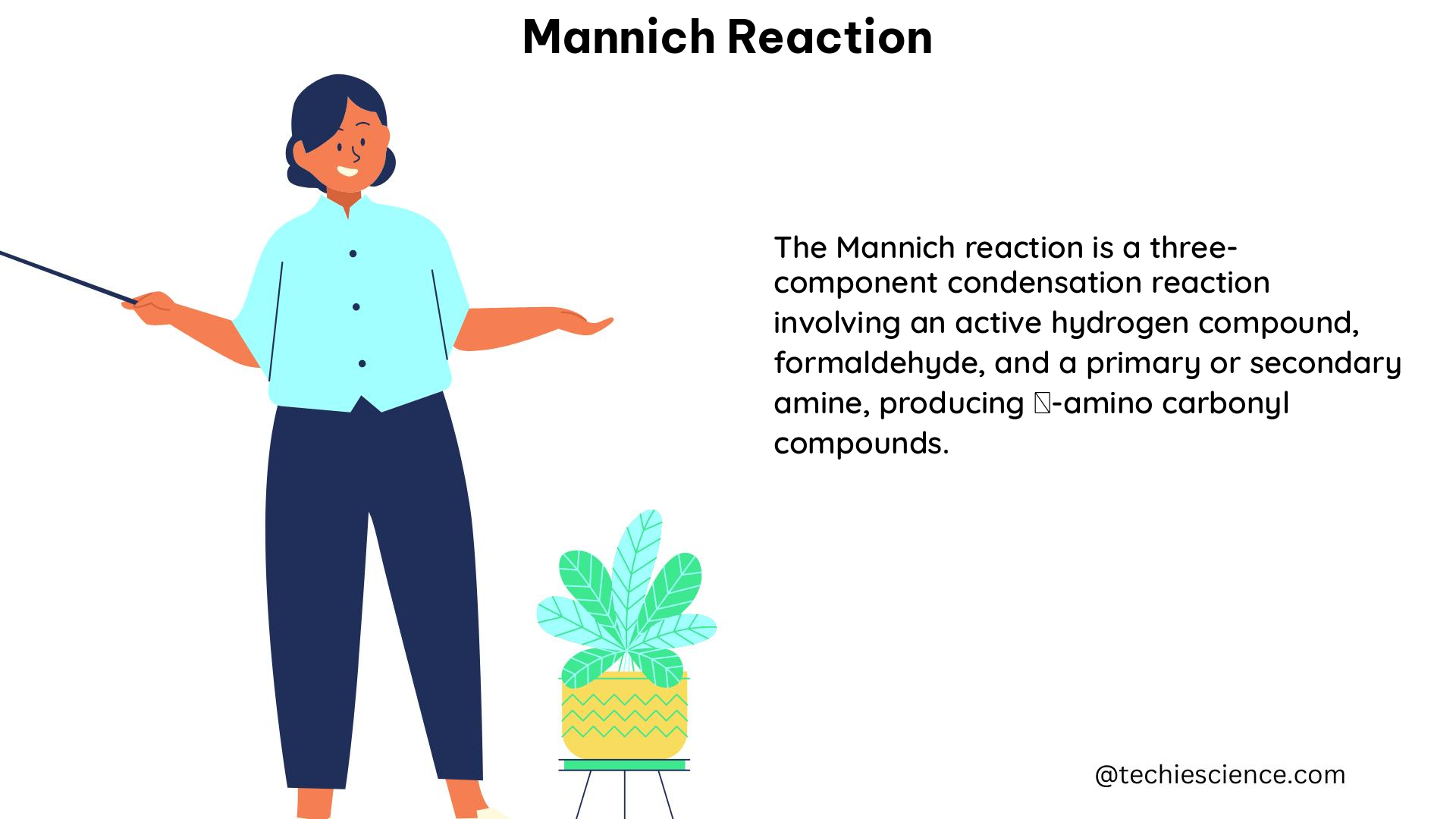The Mannich reaction is a powerful three-component condensation reaction that involves an enolizable carbonyl compound, a primary or secondary amine, and a non-enolizable aldehyde. This reaction proceeds through the formation of an iminium ion intermediate, which then reacts with the enol form of the carbonyl compound to produce a β-amino carbonyl compound known as a Mannich base. This versatile reaction has found widespread applications in organic synthesis, particularly in the synthesis of pharmaceuticals, natural products, and other fine chemicals.
Substrate Scope
The Mannich reaction can be performed with a wide range of substrates, including aldehydes, ketones, and enolizable carbonyl compounds. The reaction is particularly useful for the synthesis of β-amino carbonyl compounds, which are important intermediates in organic synthesis. Some examples of substrates that can be used in the Mannich reaction include:
- Aldehydes: Formaldehyde, acetaldehyde, benzaldehyde, and other aromatic and aliphatic aldehydes.
- Ketones: Acetone, cyclohexanone, acetophenone, and other aromatic and aliphatic ketones.
- Enolizable carbonyl compounds: Esters, amides, and other carbonyl-containing compounds that can form enol intermediates.
The choice of substrates can significantly impact the reactivity, regio- and stereoselectivity, and overall efficiency of the Mannich reaction.
Regio- and Stereoselectivity

The Mannich reaction can be controlled to provide regio- and stereoselective products. For example, the reaction of acetophenones with methylamine can afford both bis-Mannich bases and piperidinols, with the bis-Mannich bases generally being more potent cytotoxins than the corresponding piperidinols or mono-Mannich bases.
The regio- and stereoselectivity of the Mannich reaction can be influenced by various factors, such as the nature of the substrates, the reaction conditions, and the use of catalysts. Careful optimization of these parameters can lead to the selective formation of the desired Mannich base product.
Catalysis
The Mannich reaction can be catalyzed by a variety of catalysts, including transition metal salts, silicon-mediated catalysts, and organocatalysts. These catalysts can improve the efficiency and selectivity of the reaction, and can be used to perform the reaction under mild conditions.
Some examples of catalysts used in the Mannich reaction include:
- Transition metal salts: Lewis acidic metal salts, such as zinc chloride (ZnCl2), titanium tetrachloride (TiCl4), and scandium triflate (Sc(OTf)3), can catalyze the Mannich reaction.
- Silicon-mediated catalysts: Silyl enol ethers and other silicon-based reagents can be used to activate the carbonyl compound and promote the Mannich reaction.
- Organocatalysts: Bifunctional organocatalysts, such as chiral secondary amines and thioureas, can be used to achieve high levels of enantioselectivity in the Mannich reaction.
The choice of catalyst can have a significant impact on the reaction outcome, and the development of new and more efficient catalysts is an active area of research in Mannich reaction chemistry.
Enantioselectivity
The Mannich reaction can be performed with high enantioselectivity using bifunctional organocatalysts. This allows for the synthesis of enantiomerically pure β-amino carbonyl compounds, which are important intermediates in the synthesis of pharmaceuticals and other fine chemicals.
Some examples of bifunctional organocatalysts that have been used to achieve high enantioselectivity in the Mannich reaction include:
- Proline-derived catalysts
- Cinchona alkaloid-based catalysts
- Thiourea-based catalysts
- Phosphoric acid-based catalysts
The enantioselectivity of the Mannich reaction can be influenced by factors such as the catalyst structure, the reaction conditions, and the nature of the substrates. Careful optimization of these parameters is crucial for achieving high levels of enantioselectivity.
Applications
The Mannich reaction has a wide range of applications in organic synthesis, including the synthesis of pharmaceuticals, natural products, and materials. Some examples of the applications of the Mannich reaction include:
-
Pharmaceutical synthesis: The Mannich reaction has been used to synthesize a variety of biologically active compounds, such as tropinone (a precursor of atropine), various alkaloids, and other drug candidates.
-
Natural product synthesis: The Mannich reaction has been employed in the synthesis of complex natural products, such as the alkaloid strychnine and the antitumor agent camptothecin.
-
Materials chemistry: Mannich bases have been used as building blocks for the synthesis of polymers, resins, and other functional materials.
-
Lignin analysis: The Mannich reaction has been coupled with 31P NMR spectroscopy to quantitatively analyze the structure of lignin, a complex biopolymer found in plant cell walls.
-
Medicinal chemistry: Mannich bases have been extensively studied for their potential therapeutic applications, including as anticancer, antimicrobial, and anti-inflammatory agents.
The versatility and broad applicability of the Mannich reaction make it a valuable tool in the arsenal of organic chemists and materials scientists.
Conclusion
The Mannich reaction is a powerful and versatile three-component condensation reaction that has found widespread applications in organic synthesis, medicinal chemistry, and materials science. By understanding the substrate scope, regio- and stereoselectivity, catalysis, and enantioselectivity of the Mannich reaction, researchers can harness its potential to synthesize a wide range of valuable compounds and materials. As the field of Mannich reaction chemistry continues to evolve, the development of new catalysts, reaction conditions, and synthetic strategies will undoubtedly lead to even more exciting applications of this important transformation.
References
- The Mannich reaction | PPT – SlideShare. (2015). Retrieved from https://www.slideshare.net/slideshow/mannich-reaction-55403950/55403950
- Coupling P-31 NMR with the Mannich reaction for the quantitative analysis of lignin. (2016). Retrieved from https://www.researchgate.net/publication/238093247_Coupling_P-31_NMR_with_the_Mannich_reaction_for_the_quantitative_analysis_of_lignin
- Mannich bases in medicinal chemistry and drug design – PMC – NCBI. (2020). Retrieved from https://www.ncbi.nlm.nih.gov/pmc/articles/PMC7115492/
- Mannich Reaction – Organic Chemistry Portal. (n.d.). Retrieved from https://www.organic-chemistry.org/namedreactions/mannich-reaction.shtm

The lambdageeks.com Core SME Team is a group of experienced subject matter experts from diverse scientific and technical fields including Physics, Chemistry, Technology,Electronics & Electrical Engineering, Automotive, Mechanical Engineering. Our team collaborates to create high-quality, well-researched articles on a wide range of science and technology topics for the lambdageeks.com website.
All Our Senior SME are having more than 7 Years of experience in the respective fields . They are either Working Industry Professionals or assocaited With different Universities. Refer Our Authors Page to get to know About our Core SMEs.